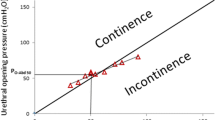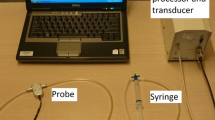Summary
Given the expense of radiographic imaging facilities and the reproducibility of urethral pressure measurements with microtransducers, the use of urethral pressure profilometry (UPP) has been gaining widespread popularity for the diagnosis of genuine stress incontinence (GSI). However, the clinical usefulness of the technique has not been adequately evaluated against the best available technique, namely videocystourethrography. Using the latter technique as the Gold Standard, the UPP results of 114 normal women and 95 GSI patients have been compared. In order to determine the most diagnostic UPP measure, 25 parameters were examined for each patient. With the use of the Kappa statistic it was found that “the area under the stress profile” was the most discriminatory of the UPP parameters. Even using this measure, the overlap between normal and GSI is so great as to make accurate diagnosis impossible. It is therefore concluded that UPP is useless for the diagnosis of GSI.
Similar content being viewed by others
References
Assmussen M, Ulmsten U (1975) Simultaneous urethrocystometry and urethral pressure profile measurement with a new technique. Acta Obstet Gynecol Scand 54:385–386
Assmussen M, Ulmsten U (1976) A new technique for measurement of the urethral pressure profile. Acta Obstet Gynecol Scand 55:167–173
Cohen J (1968) Weighted Kappa: nominal scale agreement with provision for scaled disagreement or partial credit. Psychol Bull 70:213–220
Enhorning G (1961) Simultaneous recording of intravesical and intraurethral pressure. A study on urethral closure in normal and stress incontinent women. Acta Chir Scand [Suppl] 276:1–68
Henriksson L, Andersson KE, Ulmsten U (1979) The urethral pressure profiles in continent and stress incontinent women. Scand J Urol Nephrol 13:5–10
Hilton P, Stanton SL (1983) Urethral pressure measurement by microtransducer: the results in symptom-free women and in those with genuine stress incontinence. Brit J Obstet Gynaecol 90:919–933
Londis J, Kok GG (1977) The measurement of observer agreement for categorical data. Biometrics 33:159–174
Shepherd AM, Lewis P, Howell SC, Abrams PH (1985) Video screening and stress urethral profiles — unnecessary investigations in the diagnosis of genuine stress incontinence. London Proc Int Cont Soc, pp 261–262
Toews H (1967) Intraurethral and intravesical pressures in normal and stress incontinent women. Obstet Gynaecol 29:613–624
Versi E, Cardozo LD (1986) Urethral instability diagnosis based on variations in the maximum urethral pressure in normal climacteric women. Neurourology and Urodynamics (in press)
Author information
Authors and Affiliations
Rights and permissions
About this article
Cite this article
Versi, E., Cardozo, L., Studd, J. et al. Evaluation of urethral pressure profilometry for the diagnosis of genuine stress incontinence. World J Urol 4, 6–9 (1986). https://doi.org/10.1007/BF00326733
Issue Date:
DOI: https://doi.org/10.1007/BF00326733




